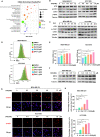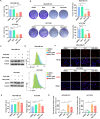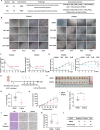Toxoflavin analog D43 exerts antiproliferative effects on breast cancer by inducing ROS-mediated apoptosis and DNA damage
- PMID: 38369538
- PMCID: PMC10874970
- DOI: 10.1038/s41598-024-53843-1
Toxoflavin analog D43 exerts antiproliferative effects on breast cancer by inducing ROS-mediated apoptosis and DNA damage
Abstract
Triple-negative breast cancer (TNBC) is regarded as the deadliest subtype of breast cancer because of its high heterogeneity, aggressiveness, and limited treatment options. Toxoflavin has been reported to possess antitumor activity. In this study, a series of toxoflavin analogs were synthesized, among which D43 displayed a significant dose-dependent inhibitory effect on the proliferation of TNBC cells (MDA-MB-231 and HCC1806). Additionally, D43 inhibited DNA synthesis in TNBC cells, leading to cell cycle arrest at the G2/M phase. Furthermore, D43 consistently promoted intracellular ROS generation, induced DNA damage, and resulted in apoptosis in TNBC cells. These effects could be reversed by N-acetylcysteine. Moreover, D43 significantly inhibited the growth of breast cancer patient-derived organoids and xenografts with a favorable biosafety profile. In conclusion, D43 is a potent anticancer agent that elicits significant antiproliferation, oxidative stress, apoptosis, and DNA damage effects in TNBC cells, and D43 holds promise as a potential candidate for the treatment of TNBC.
Keywords: DNA damage; N-acetylcysteine (NAC); Patient-derived breast cancer organoids (PDO); ROS; Toxoflavin.
© 2024. The Author(s).
Conflict of interest statement
The authors declare no competing interests.
Figures





Similar articles
-
Ginger-Derived 3HDT Exerts Antiproliferative Effects on Breast Cancer Cells by Apoptosis and DNA Damage.Int J Mol Sci. 2023 Mar 17;24(6):5741. doi: 10.3390/ijms24065741. Int J Mol Sci. 2023. PMID: 36982818 Free PMC article.
-
Boesenbergia stenophylla-Derived Stenophyllol B Exerts Antiproliferative and Oxidative Stress Responses in Triple-Negative Breast Cancer Cells with Few Side Effects in Normal Cells.Int J Mol Sci. 2023 Apr 24;24(9):7751. doi: 10.3390/ijms24097751. Int J Mol Sci. 2023. PMID: 37175458 Free PMC article.
-
Yttrium Oxide nanoparticles induce cytotoxicity, genotoxicity, apoptosis, and ferroptosis in the human triple-negative breast cancer MDA-MB-231 cells.BMC Cancer. 2023 Nov 27;23(1):1151. doi: 10.1186/s12885-023-11649-w. BMC Cancer. 2023. PMID: 38012585 Free PMC article.
-
A novel star-shaped trinuclear platinum(II) complex based on a 1,3,5-triazine core displaying potent antiproliferative activity against TNBC by the mitochondrial injury and DNA damage mechanism.Dalton Trans. 2022 Jul 26;51(29):10930-10942. doi: 10.1039/d2dt00895e. Dalton Trans. 2022. PMID: 35731536
-
Curcumin sensitizes carboplatin treatment in triple negative breast cancer through reactive oxygen species induced DNA repair pathway.Mol Biol Rep. 2022 Apr;49(4):3259-3270. doi: 10.1007/s11033-022-07162-1. Epub 2022 Jan 25. Mol Biol Rep. 2022. PMID: 35076853
Cited by
-
Phytochemical Composition and Bioactivities of Some Hydrophytes: Antioxidant, Antiparasitic, Antibacterial, and Anticancer Properties and Mechanisms.Plants (Basel). 2024 Aug 2;13(15):2148. doi: 10.3390/plants13152148. Plants (Basel). 2024. PMID: 39124266 Free PMC article.
-
LHX3 promotes EMT in hepatoma cell through β-catenin/TCF4 pathway.Med Oncol. 2024 Dec 19;42(1):33. doi: 10.1007/s12032-024-02585-1. Med Oncol. 2024. PMID: 39702693
-
Identification of four novel Streptomyces isolated from machair grassland soil using a culture-based bioprospecting strategy: Streptomyces caledonius sp. nov., Streptomyces machairae sp. nov., Streptomyces pratisoli sp. nov. and Streptomyces achmelvichensis sp. nov.Int J Syst Evol Microbiol. 2025 Apr;75(4):006736. doi: 10.1099/ijsem.0.006736. Int J Syst Evol Microbiol. 2025. PMID: 40208665 Free PMC article.
References
MeSH terms
Substances
Grants and funding
LinkOut - more resources
Full Text Sources
Miscellaneous

